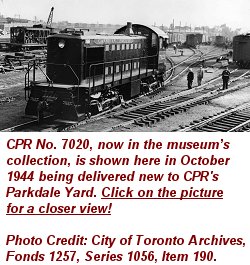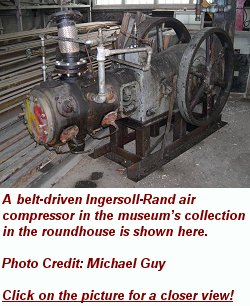 |

 | |
Railway museums and other museums of technology tend to focus exclusively on the "hardware" associated with their subjects, placing insufficient emphasis on the human process that surrounds the object. The steam locomotive is an ideal example of an extremely labour-intensive machine whose presence had a profound impact on society. The rise of Toronto to industrial prominence in the late 19th century is directly attributable to the commercial possibilities created by the steam engine. To ignore the human envelope of its career is to lose most of the story that the artifact has to tell.
We conceive the Toronto Railway Museum as more than a collection of "things"; we wish it to be a host for the memory of all the human components associated with Torontoís railway heritage. And this goes far beyond the locomotive - it includes telling the moving stories of significant episodes in the whole history of the developing Canadian diversity, such as the unique role of immigrant communities in the initial construction of railways, the complex significance of employment in the sleeping car service for the black community, the role of female employees during World War II, and the understated part played by Canadian passenger trains in every wave of immigration to Toronto from the completion of the Grand Trunk main line between New England and Ontario in 1857 to the period following the Second World War.
In North America, there appear to be two schools of thought with respect to how a technology museumís collection should be presented. The dominant outlook appears to be that of the entertainment manager who uses the artifact in gimmicky ways to entertain the visitor, regardless of its unique character. For this type of museum management, the preserved object is useful only insofar as it can provoke a limited response with little or no effort on the part of the visitor.
At the Toronto Railway Museum, we will pursue a different course. The preserved object will be interpreted - set into its proper context - and the objective can be deliberately educational. We will manage the preserved objects in a way that recognizes their intrinsic value as evidence of the past and recognizes that contextual orientation is an essential precursor to a useful understanding of the object. This will take a variety of forms, including short interactive computer/video presentations for visitors arriving at the door (introduction to steam locomotive technology, introduction to railway history in Toronto, etc.) as well as detailed guide books, guest lectures on various themes and other publications.
It is recognized that to provide full contextual orientation, mechanical artifacts such as steam locomotives need to be operable and to operate regularly. It will be a primary goal of the museum to work towards this end, first with CNR No. 6213 and the turntable, then with other artifacts as they may become available. The museum should be a place where the complex and sometimes obscure past is preserved, shown in operation and explained.
Given the broad geographical spread of the museum (i.e. from Scott Street to John Street, and from Front Street to Lakeshore Boulevard), we believe new technology may be the ideal solution to provide visitors with a high quality interpretative resource. Similar in basic concept to the type of audio guide one now uses in art galleries, we are proposing the development of a wireless digital audio-visual guide, with many of the features of a personal digital assistant, which visitors could use interactively to obtain basic or more detailed information on the sites and artifacts during their visit. The database for this guide would be developed as a function of the archive and library of the museum, which would also provide support to a strong virtual presence for the museum on the Internet.
|
|
 |





